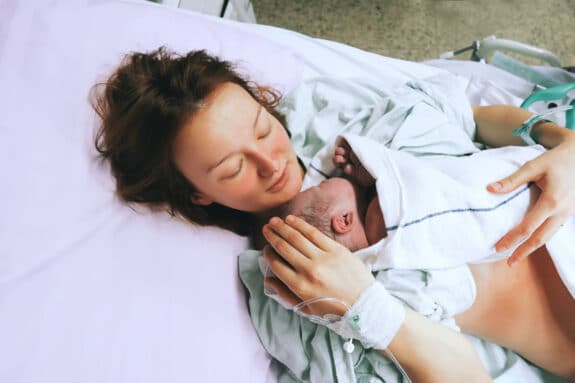The journey of childbirth is one of the most incredible experiences a woman can go through. As the baby grows, the mom’s body adjusts to nurture and protect the developing fetus. While this is a remarkable time, a new study looks at the long-term issues and complications that occur in the perinatal period and whether women are receiving the best care after they give birth.
Key takeaways:
- Maternal mortality has seen significant progress in reduction over the past three decades, however, the focus on mortality reduction has led to the neglect of medium-term and long-term complications of labour and childbirth
- These conditions can have lifelong social, economic, and health consequences, particularly in low- and middle-income countries
- An interplay of human evolution, maternal physiology, and inherent predispositions contribute to these conditions
- We need to prioritize the prevention, identification, and treatment of these neglected conditions to meet the targets of Sustainable Development Goal 3.
Maternal morbidity and mortality caused by labor and childbirth have been a major focus of global health initiatives for the past three decades. However, many medium-term and long-term complications that arise from labor and childbirth, such as depression, urinary and anal incontinence, and sexual dysfunction, are often overlooked. These conditions can have lifelong social, economic, and health consequences, and are especially common in low- and middle-income countries.
A paper, published in the Lancet, explores the spectrum of medium-term and long-term complications that can arise from labor and childbirth and examines the interplay between human evolution, maternal physiology, and inherent predispositions to these complications. It also provides actionable recommendations to help achieve the targets of the 2030 Sustainable Development Goals. This paper is the third in a series of four papers about maternal health in the perinatal period and beyond.
The labor and childbirth process can have long-term implications on a woman’s physical, mental, and sexual health. Common conditions related to labor and childbirth include urinary and anal incontinence, pelvic organ prolapse, dyspareunia, postpartum depression, post-traumatic stress disorder, postpartum psychosis, thyroid dysfunction, mastitis, HIV seroconversion, nerve injury, chronic anemia, and secondary infertility. These conditions can be caused by the natural changes of pregnancy, social and clinical factors, fetal factors, and intrapartum complications.
While many labor and childbirth interventions are offered to reduce harm, their misuse or overuse can lead to iatrogenic complications. Factors such as birth in an unfamiliar environment, sleep deprivation, breastfeeding difficulties, and low support in parenting can also increase the risk of postpartum depression. Additionally, the longer the labor duration, the greater the likelihood of interventions, which can interfere with a woman’s recovery and increase the risk of adverse physical, social, or psychological outcomes. To address these conditions, comprehensive health service opportunities and multidisciplinary models of care that extend beyond 6 weeks postpartum are needed. High-quality guidelines emphasize the importance of good-quality care at birth, systematic clinical assessments, and screening of postpartum women to identify those at risk.
Adverse conditions affecting women during the postpartum period can range from mild to severe. Dyspareunia (painful sexual intercourse) has a prevalence of 35% among postpartum women, with 43% of women experiencing it from 2 months to 6 months postpartum and 40% from 12 months to 24 months. Anal and urinary incontinence with prevalence rates ranging from 8-31% and 8-24% respectively are also very common postpartum. Postpartum depression, anxiety, and tokophobia (severe fear of childbirth) are also prevalent, and occur more often in low- and middle-income countries (LMICs). Secondary infertility, pelvic organ prolapse, postpartum PTSD, postpartum thyroid dysfunction, lactational mastitis, HIV seroconversion, and lower-extremity nerve injury may also occur in 1-10% of women during the postpartum period. Risk factors for the development of these conditions include age, race and ethnicity, educational status, BMI, comorbidities, and hysterectomy.
Postpartum women in High-Income Countries (HICs) are at a high risk of developing several health complications. The most common issue new moms experienced was urinary incontinence. Between 6 weeks and 12 months, it was 31%, with the prevalence ranging between 10% and 63%. Stress urinary incontinence was estimated at 7.9%, 12-19%, 13.3%, and 15%.
Postpartum depression prevalence was reported to be 14%, with a range of 12.9% at 8 weeks postpartum, 17.4% at 12 weeks postpartum, and 13.6% at 24 weeks postpartum.
Women that experienced secondary infertility was 10.5%. Postpartum sexual dysfunction including dyspareunia – painful intercourse – was reported to be 35%, with 43% experiencing it from 2 to 6 months postpartum, 22% from 6 to 12 months postpartum, and 40% from 12 to 24 months postpartum.
The commonness of postpartum anxiety disorder was 16%, and postpartum psychosis was reported to be 5 in 1,000 women. Fear of childbirth was estimated to be between 6.3% and 14.8%, whereas Peripartum cardiomyopathy was reported to have a prevalence of 33.5 per 100,000 live births in women aged 15-35 years and 77.6 per 100,000 live births in women aged 36-54 years.
The incidence of venous thromboembolism during pregnancy and puerperium was 1.4 per 1000, and the absolute risk of uterine rupture in vaginal birth after cesarean section was 0.87%. Chronic wound pain after a cesarean section was 15.4%, and the prevalence of cesarean section scar defect ranged between 24% and 88%.
New moms experienced lactational mastitis 11.1 episodes per 1000 breastfeeding weeks. The pooled HIV incidence rate was 2.9 per 100 person-years postpartum, and the increased absolute risk of placenta accreta following cesarean section was 3.3 per 10,000 births for no cesarean section, 12.9 per 10,000 births after one cesarean section, and up to 230 per 10,000 births for five or more cesarean sections. It was reported that abruption ranged from 0.01% to 5.1%.
How often medium and long-term conditions arise from labor and childbirth is an important factor to consider when discussing women’s health. A systematic review of 157 guidelines identified 46 high-quality guidelines from 72 different organizations. These guidelines cover a range of conditions, such as postpartum depression, urinary incontinence, uterine and wound complications, and postpartum anxiety, as well as a few high-quality guidelines for other conditions, such as fistula, mastitis, and postpartum thyroiditis. The guidelines suggest clinical assessments or formal screening using validated tools to identify those at risk of adverse conditions. Additionally, these guidelines emphasize the importance of women-centered and evidence-based care to provide timely and effective preventative or reparative measures.
This paper has highlighted the neglected medium-term and long-term consequences of labour and childbirth that are often overlooked in the global health agenda and national action plans due to the historical limitation of postnatal care services. Governments, health systems, and other stakeholders must prioritize these conditions to ensure quality maternal health care in the perinatal period(pregnancy to 24 months postnatal) and beyond.
More Childbirth News:








